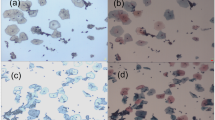Abstract
Background
Development of a nonendoscopic test for Barrett’s esophagus would revolutionize population screening and surveillance for patients with Barrett’s esophagus. Swallowed cell collection devices have recently been developed to obtain cytology brushings from the esophagus: automated detection of neoplasia in such samples would enable large-scale screening and surveillance.
Methods
Fourier transform infrared (FTIR) spectroscopy was used to develop an automated tool for detection of Barrett’s esophagus and Barrett’s neoplasia in esophageal cell samples. Cytology brushings were collected at endoscopy, cytospun onto slides and FTIR images were measured. An automated cell recognition program was developed to identify individual cells on the slide.
Results
Cytology review and contemporaneous histology was used to inform a training dataset containing 141 cells from 17 patients. A classification model was constructed by principal component analysis fed linear discriminant analysis, then tested by leave-one-sample-out cross validation. With application of this training model to whole slide samples, a threshold voting system was used to classify samples according to their constituent cells. Across the entire dataset of 115 FTIR maps from 66 patients, whole samples were classified with sensitivity and specificity respectively as follows: normal squamous cells 79.0% and 81.1%, nondysplastic Barrett’s esophagus cells 31.3% and 100%, and neoplastic Barrett’s esophagus cells 83.3% and 62.7%.
Conclusions
Analysis of esophageal cell samples can be performed with FTIR spectroscopy with reasonable sensitivity for Barrett’s neoplasia, but with poor specificity with the current technique.



Similar content being viewed by others
References
Fitzgerald RC, di Pietro M, Ragunath K, et al. British Society of Gastroenterology guidelines on the diagnosis and management of Barrett’s oesophagus. Gut. 2014;63:7–42.
Shu YJ. Cytopathology of the esophagus. An overview of esophageal cytopathology in China. Acta Cytol. 1983;27:7–16.
Dawsey SM, Shen Q, Nieberg RK, et al. Studies of esophageal balloon cytology in Linxian, China. Cancer Epidemiol Biomark Prev. 1997;6:121–30.
Spechler S. Barrett’s esophagus: should we brush off this ballooning problem? Gastroenterology. 1997;112:2138–42.
Falk GW, Chittajallu R, Goldblum JR, et al. Surveillance of patients with Barrett’ s esophagus for dysplasia and cancer with balloon cytology. Gastroenterology. 1997;112:1787–97.
Hughes JH, Cohen MB. Is the cytologic diagnosis of esophageal glandular dysplasia feasible ? Diagn Cytopathol. 1998;18:312–6.
Geisinger KR, Teot LA, Richter JE. A comparative cytopathologic and histologic study of atypia, dysplasia, and adenocarcinoma in Barrett’s esophagus. Cancer. 1992;69:8–16.
Hardwick RH, Morgan RJ, Warren BF, et al. Brush cytology in the diagnosis of neoplasia in Barrett’s esophagus. Dis Esophagus. 1997;10:233–7.
Ross-Innes CS, Debiram-Beecham I, O’Donovan M et al. Evaluation of a minimally invasive cell sampling device coupled with assessment of trefoil factor 3 expression for diagnosing Barrett’s esophagus: a multi-center case–control study. PLoS Med. 2015;12:e1001780.
Kadri SR, Lao-Sirieix P, O’Donovan M, et al. Acceptability and accuracy of a non-endoscopic screening test for Barrett’s oesophagus in primary care: cohort study. BMJ. 2010;341:c4372.
Old O, Fullwood L, Scott R, et al. Vibrational spectroscopy for cancer diagnostics. Anal Methods. 2014;6:3901–17.
Wang TD, Triadafilopoulos G, Crawford JM, et al. Detection of endogenous biomolecules in Barrett’s esophagus by Fourier transform infrared spectroscopy. Proc Natl Acad Sci U S A. 2007;104:15864–9.
Quaroni L, Casson AG. Characterization of Barrett esophagus and esophageal adenocarcinoma by Fourier-transform infrared microscopy. Analyst. 2009;134:1240–6.
Amrania H, Antonacci G, Chan C-H, et al. Digistain: a digital staining instrument for histopathology. Opt Express. 2012;20:7290–9.
Townsend D, Miljković M, Bird B, et al. Infrared micro-spectroscopy for cyto-pathological classification of esophageal cells. Analyst. 2015;140:2215–23.
Schubert JM, Bird B, Papamarkakis K, et al. Spectral cytopathology of cervical samples: detecting cellular abnormalities in cytologically normal cells. Lab Investig. 2010;90:1068–77.
Papamarkakis K, Bird B, Schubert JM, et al. Cytopathology by optical methods: spectral cytopathology of the oral mucosa. Lab Investig. 2010;90:589–98.
Miljković M, Bird B, Lenau K, et al. Spectral cytopathology: new aspects of data collection, manipulation and confounding effects. Analyst. 2013;138:3975–82.
Old OJ, Lloyd GR, Nallala J, et al. Rapid infrared mapping for highly accurate automated histology in Barrett’s oesophagus. Analyst. 2016;142:1227–1234
Gajjar K, Ahmadzai A, Valasoulis G, et al. Histology verification demonstrates that biospectroscopy analysis of cervical cytology identifies underlying disease more accurately than conventional screening: removing the confounder of discordance. PLoS One. 2014;9:e82416.
Bird B, Romeo MJ, Diem M, et al. Cytology by infrared micro-spectroscopy: automatic distinction of cell types in urinary cytology. Vib Spectrosc. 2008;48:101–6.
Baker MJ, Trevisan J, Bassan P, et al. Using Fourier transform IR spectroscopy to analyze biological materials. Nat Protoc. 2014;9:1771–91.
Bassan P, Byrne HJ, Bonnier F, et al. Resonant Mie scattering in infrared spectroscopy of biological materials—understanding the “dispersion artefact”. Analyst. 2009;134:1586–93.
Bassan P, Kohler A, Martens H, et al. Resonant Mie scattering (RMieS) correction of infrared spectra from highly scattering biological samples. Analyst. 2010;135:268–77.
Acknowledgements
The authors thank Doug Townsend and Max Diem from Northeastern University, Boston, for all their advice on many technical aspects of spectral cytopathology. Oliver Old was in receipt of a Royal College of Surgeons of England Surgical Research Fellowship during this study.
Author information
Authors and Affiliations
Corresponding author
Ethics declarations
Conflict of interest
The authors declare that they have no conflict of interest.
Electronic supplementary material
Below is the link to the electronic supplementary material.
Rights and permissions
About this article
Cite this article
Old, O., Lloyd, G., Isabelle, M. et al. Automated cytological detection of Barrett’s neoplasia with infrared spectroscopy. J Gastroenterol 53, 227–235 (2018). https://doi.org/10.1007/s00535-017-1344-z
Received:
Accepted:
Published:
Issue Date:
DOI: https://doi.org/10.1007/s00535-017-1344-z




